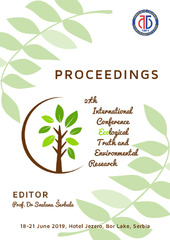| dc.creator | Bartolić, Dragana | |
| dc.creator | Stanković, Mira | |
| dc.creator | Mitrović, Aleksandra Lj. | |
| dc.creator | Mutavdžić, Dragosav | |
| dc.creator | Simonović Radosavljević, Jasna | |
| dc.creator | Radotić, Ksenija | |
| dc.date.accessioned | 2023-03-07T10:13:51Z | |
| dc.date.available | 2023-03-07T10:13:51Z | |
| dc.date.issued | 2019 | |
| dc.identifier.isbn | 978-86-6305-097-6 | |
| dc.identifier.uri | http://rimsi.imsi.bg.ac.rs/handle/123456789/1794 | |
| dc.description.abstract | Maize seeds are a primary source of nourishment and their viability is a critical consideration to
ensure a reasonably high harvest and seed quality. In this work, we study the effect of aflatoxin
induced stress on the seed viability concerning the germination, as well as the estimation on the
impact on the viability using fluorescence spectroscopy. Our results showed that the contaminated
seeds exhibit significant decreases in the percent of germination, even at low levels, if compared to the
uncontaminated seeds (P < 0.05). Furthermore, the fluorescence ratio of 453/680 and 680/751, could
be used for the rapid screening of the viability of the maize seeds. | sr |
| dc.language.iso | en | sr |
| dc.publisher | University of Belgrade, Technical Faculty in Bor | sr |
| dc.relation | info:eu-repo/grantAgreement/MESTD/Basic Research (BR or ON)/173017/RS// | sr |
| dc.rights | openAccess | sr |
| dc.source | 27th International Conference Ecological Truth and Environmental Research | sr |
| dc.subject | maize (Zea mays L.) | sr |
| dc.subject | Seed viability | sr |
| dc.subject | aflatoxin stress | sr |
| dc.subject | fluorescence ratios | sr |
| dc.title | Viability assessment of maize (Zea mays L.) seeds contaminated with aflatoxin using fluorescence spectroscopy | sr |
| dc.type | conferenceObject | sr |
| dc.rights.license | ARR | sr |
| dc.citation.epage | 304 | |
| dc.citation.spage | 301 | |
| dc.identifier.fulltext | http://rimsi.imsi.bg.ac.rs/bitstream/id/8476/bitstream_8476.pdf | |
| dc.identifier.rcub | https://hdl.handle.net/21.15107/rcub_rimsi_1794 | |
| dc.type.version | publishedVersion | sr |

